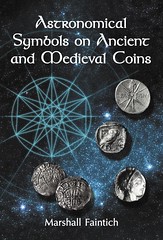
PREV ARTICLE
NEXT ARTICLE
FULL ISSUE
PREV FULL ISSUE
BOOK REVIEW: ASTRONOMICAL SYMBOLS ON ANCIENT AND MEDIEVAL COINS
Kavan Ratnatunga submitted this review of Marshall Faintich's book, Astronomical Symbols on Ancient and Medieval Coins. Thanks!
-Editor
Review by Dr Kavan U. Ratnatunga (Astrophysicist and Numismatist)
Over a decade ago when I looked for information about Coins and Astronomy I found Marshall Faintich's website "Symbolic Messengers" hosted on OurWorld of CompuServe. It was one of only two websites dealing with the subject and I linked from the page I created for Lankan coins with Astronomy symbols. OurWorld in no more and the website has now moved to its own domain symbolicmessengers.com. I am very happy to find that Marshall Faintich has expanded his website into a comprehensive book on Astronomy symbols on Coins Ancient and Medieval Europe. To quote late Philip Grierson (1910-2006), who was Professor of Numismatics at University of Cambridge: Numismatics, like some aspects of astronomy and natural history, remains a branch of learning in which the amateur can still do valuable work, and it is on the great collecting public, or rather on that part of which is interested in the subject at a scientific level, that the progress of numismatic science largely depends. This book covers both these fields The rate of rotation of the Earth is slowing very slightly and it is estimated that the length of the modern day appears to have increased by a surplus of about +0.05 seconds from the length of the ancient day 2500 years ago. The resulting cumulative correction of Universal Time known as Delta-T amounts to about 4.7 hours when you compute astronomical events back in 500 BCE. Before 1600 AD this can only be estimated empirically by records of Solar Eclipses, the most ancient of which are mainly from China. The consistency of the European numismatic record of Eclipses as shown in this book is an independent confirmation of the adopted Delta-T estimates. As the Author admits it is unlikely that all the symbols identified as astronomical on over 400 coins illustrated in this book are factual, but it is clear that a large majority of them probably have been correctly identified. All of the coins are illustrated with clear line drawing. It is a pity that images of few of the actual coins were not shown as images. Few of the coin images can however be seen on his symbolicm essengers website. I hope he expands that site with more images and references to the discussion in the book. Faintich gives many examples of the Sun, Moon and 5 planets known to the ancients and their conjunctions, as well as comets and Galactic SuperNova visible in daylight that were recorded on Ancient and Medieval European coins. Astronomical Symbols are also found on coins of south Asia including Lanka. I found it interesting that some of the same symbols such as the "three pellets" are found on Ancient Lankan coins which were first issued in 2 century BC. Each culture seems to have their own interpretation for this symbol which probably has a common ancient origin. The crescent Sun during a partial eclipse is represented like a crescent Moon, however the orientation of the crescent should give some indication. The cusps of the crescent which point away from the Sun can't be seen pointing down at night. Another recommendation for anyone trying to match coins with ancient Eclipses is to use the NASA Eclipse website which has a Five Millennium Catalog of Solar Eclipses at http://eclipse.gsfc.nasa.gov/SEcat5/SEcatalog.html This site is simpler to use than any program and adopts the current best algorithms and estimates for delta-T. This book was published in 2008 should have gotten more publicity in 2009, the International Year of Astronomy when many nations issued coins to commemorate IYA2009 and there is a new set of coins with Astronomical Symbols. Archaeoastronomy is becoming a growing field of interest. An IAU Symposium 278 (Oxford IX conference): "Archaeoastronomy and Ethnoastronomy: Building Bridges between Cultures", is being sponsored by IAU Division XII, on 2011 Jan 5-12 in Lima, Peru. See http://www.archaeoastronomy.org/ . I hope Marshall Faintich presents his findings at this conference. Although the emphasis of the book on Medieval European coins, the book will serve as a very useful handbook for anyone attempting a similar study of other regions and cultures and other Eras. I recommend it for any Numismatic Library.
http://www.symbolicmessengers.com/primer.htm
To read the earlier E-Sylum review, see:
BOOK REVIEW: ASTRONOMICAL SYMBOLS ON ANCIENT AND MEDIEVAL COINS
(www.coinbooks.org/club_nbs_esylum_v13n26.html#article6)
The Numismatic Bibliomania Society is a non-profit organization promoting numismatic literature. See our web site at coinbooks.org. To submit items for publication in The E-Sylum, write to the Editor at this address: whomren@gmail.com To subscribe go to: https://my.binhost.com/lists/listinfo/esylum All Rights Reserved. NBS Home Page Contact the NBS webmaster 
|
